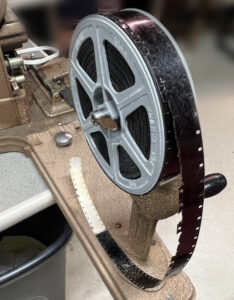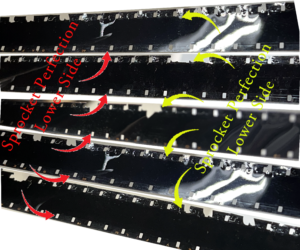
Prospective clients often think that their films of 5 and 6 and 7 decades vintage might have aged beyond any ability to duplicate to digital. The easy answer to that mode of thinking is, “Uh, I don’t think so.” As long as you don’t smell a scent of strong vinegar on your films, you are pretty much guaranteed that they are good to go and will return stunning results.
However, there are cases where films have a history of being abused as is the case with the present example adjudicated to be… the most distressed movie film reel that we have EVER received.
First, notice that the reel is filled to the brim with film to the point where it was falling off the edges. The reel was only intended to hold 100 feet of film but this one had an extra 50 feet loaded.
The photo shown presents several sections of film from its entire 150 feet suggesting distressed sprocket holes for its entire length. Such proved to be true. The entire 150 feet of film had sprocket holes distressed from stem to stern.
One might therefore be logically inclined to ask, “How did this happen–Distressed sprocket holes on one side but not the other?” The answer is that both sides of sprocket holes are used by the camera for the exposure of the film. This is necessary to guarantee perfectly aligned torque applied to the film as the camera claws reach out to pull down the film one exact frame. Angular torque is guaranteed to be applied at 90 degrees. However, Projectors only use one side of sprocket holes since precise film registration is not necessary. In short, for projections purposes, there is a lot of slop.

Consequently, this reel of film has a history whereby it was run through a projector improperly threaded. But what makes matters worse, the film apparently was allowed to project for its entire length with a severely miss-aligned threading. It would be impossible to miss such an event as the projector would be making a very destressed sound and the projected image would have been a total unintelligible mess.
At first glance, our thought at W. Cardone Productions was that the reel was not able to be duplicated to digital. But we started to think out of the box.
Suppose that we wound the film onto a spare reel as if it were a take-up reel. What would this do? Suppose we then mounted the “takeup-reel” on the projector as if it were a regular forward reel. The “good” sprocket holes would be on the same side as the projector’s drive sprockets. Projecting the “take-up” reel would produce a movie that was playing in reverse and upside down. It was a simple matter in the video editor to reverse the imaging to produce a duplication every bit as good as if it were produced in the usual fashion.
Please view the video where all this was accomplished.
